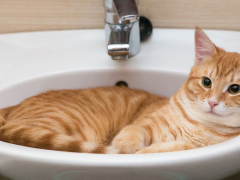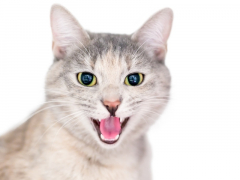
TarasBeletskiy / Shutterstock.com
If your cat is not eating but acting normal, it can be a bit disconcerting. Are they sick or aren’t they? What could be wrong? It can be hard to tell whether to worry and what to do. Some signs of ill health are very subtle in cats, and a reduced appetite is a common symptom of many feline ailments, including dental disease, pancreatitis, and gastrointestinal issues, so it’s important to take note of your cat’s eating habits and know when to take action.
Key Takeaways
Cats can refuse to eat while still acting normally as an early sign of illness, or due to pain, heat or stress.
Many common cat health conditions can reduce appetite, including dental disease and tummy upset.
If your cat hasn’t eaten for more than 24 hours, seek veterinary advice, even if you cat is acting normally.
10 Reasons Why Your Cat Isn’t Eating but Is Acting Normally
A lack of appetite can be caused by many things, ranging from minor issues with their diet to more concerning problems, such as an underlying medical condition. Let’s go through some of the common potential causes, and how to best help your cat.
1. Dietary Change
Cats are sensitive to subtle changes in their diets, and can have distinct food preferences. If your cat has changed their eating habits but seems otherwise well, the first thing to check is their food. Ask yourself these questions:
- Have you changed the food brand or type (i.e., switched from kibble to wet food)?
- Have the flavors or textures of the food changed?
- Have you moved the food bowl location, size, or type?
- Have you changed feeding time or daily routine?
- Is another cat (or other pet) preventing them access to their food bowl?
If the answer to any of these questions is “yes,” this might be enough to affect your cat’s appetite. Try resetting back to normal food type, timing, and location to encourage your cat to eat. You can still make changes to your cat’s diet if needed, but remember to do so very gradually.
2. Stress
Did you know that one of the most common reasons for a decreased appetite in cats is stress? But what on earth do our pampered pets have to be stressed about? Well, stress in cats is actually very common and can be caused by multiple factors, including a new pet or person in the household, loud noises, changes to routine, disruption to their home environment, or territorial disputes.
Stress can manifest in subtle ways in cats, with behavioral changes such as hiding away or altered interaction with owners commonly seen. However, stress can also cause physical effects, including bladder inflammation and weight loss, so it definitely needs tackling.
If your cat has changed their routines or habits but is medically well, try enhancing their environment with plenty of hiding places, provide safe toileting and feeding areas away from other pets, and try to keep to a consistent and predictable routine.
3. Heat
Environmental changes can contribute to a cat’s lack of appetite. Cats tend to sleep more when the weather is hot, and this will decrease their energy requirement and, therefore, their food intake. This change should be temporary and mild.
Ensure your cat has cool places to rest and plenty of fresh water available to quench their thirst and stay hydrated. Keep offering small amounts of food. Wet food can quickly go rancid in heat, so remove uneaten food promptly.
4. Vaccination

A recent vaccination can make some cats feel a little unwell for 24 to 48 hours, which can reduce appetite. sematadesign / Shutterstock.com
Routine vaccinations are recommended for cats to avoid preventable illnesses and promote health and vitality. They generally carry a low risk of adverse effects, however some cats can suffer from lethargy and a minor fever for 24 to 48 hours after the vaccine, which can then affect appetite.
If your cat has had a recent vaccination and is now not eating but otherwise seems well, this can be normal and should quickly resolve. Keep them quiet and tempt them to eat with small amounts of highly palatable food. Contact a veterinarian for advice if their appetite doesn’t resume after a day.
5. Tooth Pain
Dental disease is very common in cats, with one study finding that 15% of cats in primary care veterinary practice were suffering from dental disease—the most common problem found. Any problems with the teeth or gums can be very painful, which is a sure way to reduce a cat’s desire to eat and chew. Sometimes the only sign is lack of appetite, with cats otherwise appearing completely normal, but you might see other symptoms, such as drooling saliva, pawing at the mouth, or dropping food from the mouth while eating.
Your veterinarian can examine your cat’s mouth for signs of disease and pain. To improve oral health, get your cat’s teeth checked regularly, try to establish a tooth-cleaning routine, and encourage chewing on suitable toys.
6. Upset Stomach
Conditions of the gastrointestinal tract are usually thought of as fairly obvious to spot, with signs like vomiting and diarrhea making themselves known. However, symptoms can be more subtle, with nausea and gradual weight loss common but much more difficult to spot.
A cat being off their food can be an early indication of many GI conditions, including gastroenteritis, irritable bowel disease, and even cancer. Cats can also suffer from pancreatitis (inflammation of the pancreas), which is notoriously difficult to spot due to its vague and waxing-waning symptoms.
7. Respiratory Disease
The association between respiratory conditions, such as cat flu, and appetite might not be so obvious, but cats with the sniffles and sneezes often go off their food. Cats are attracted to food mostly by scent rather than taste, and a plugged-up nose will often affect appetite.
It’s unusual to see respiratory disease with a lack of appetite as the only symptom, but it can be an early sign of something brewing. Try cleaning any discharge from around the nose with a soft, wet cloth, and offer foods that have a strong aroma to encourage eating.
8. Pain
Any form of discomfort and pain can impact appetite. Cats are very good at concealing pain, so unless you’re well-versed in cat body language and communication, it might seem as though they are acting normally other than not eating well. Look out for subtle changes to your cat’s behavior, interactions, and routines, which might indicate that all is not well. If your cat has a painful chronic medical condition, such as arthritis, they might benefit from pain relief medication to improve their comfort levels and restore their appetite.
9. Other Medical Conditions
Some more severe health conditions can cause inappetence in cats. Cancer, heart failure, kidney disease, liver disease, and diabetes can all suppress appetite. You can usually spot other signs of illness with these more serious health conditions, such as lethargy, vomiting and/or diarrhea, breathing problems, and weight loss, but a cat that has recently stopped eating can be an early sign of more serious problems to come.
Early intervention leads to more rapid diagnosis, treatment, and often a better outcome, so always seek veterinary attention if you are concerned about your pet.
10. Medications
If your cat has already been diagnosed with a health problem and is on medication, be aware that some medicines can depress appetite. This can be a temporary suppression or can have more lasting effects, which may need to be countered with appetite stimulants or other assistance. Your vet will be able to advise you on how to manage the consequences of specific treatment protocols.
What You Can Do

Tempt cats to eat in a quiet, calm environment with small portions of wet food with a strong aroma. osobystist / Shutterstock.com
A can that isn’t eating well is always a concern—even if they’re acting perfectly normal otherwise. Cats that stop eating are at risk of hepatic lipidosis (fatty liver disease), where the liver gets inundated with fat cells released from the body’s fat stores. This infiltration prevents the liver from working normally and eventually leads to liver failure. It’s important to seek veterinary advice if your cat isn’t eating and the problem doesn’t resolve within 24 hours.
There are some tips and tricks you can try at home:
- Gentle encouragement: if your cat is a fussy eater, encourage them to eat by providing extra-palatable food, providing a calm and predictable environment, and using food toppers or additives.
- Remove uneaten food: Although it might seem counterproductive to remove food, if your cat is feeling off-color, it can easily develop an aversion to certain scents and textures if forced into contact with food. Offer small amounts of palatable food regularly, but remove them promptly if not eaten.
- See a vet: If your cat stops eating for more than 24 hours, it’s time to see a vet, even if they seem otherwise well. Your veterinarian can examine your cat and perform any diagnostic tests necessary, including bloodwork, ultrasound, or x-rays. They might also be able to provide an appetite stimulant to help your cat eat while the underlying problem is being investigated.
Frequently Asked Questions
When should I worry about my cat not eating?
Cats can develop fatty liver disease if they go without food for more than a couple of days. If your cat hasn’t eaten in more than 24 hours, seek veterinary attention promptly.
Why does my cat seem interested in food but won’t eat?
If your cat seems to want to eat food but can’t, they might have a problem with their mouth, teeth, or gums causing pain or discomfort. They might also be feeling nauseous or unwell. Many health problems, such as gastrointestinal disease, kidney disease, and diabetes, can affect appetite.
Do cats go through phases of not eating?
A cat’s appetite might wax and wane with various factors including their activity level and the ambient temperature. However, these variations should be very minimal. Large changes in appetite—or not eating at all—are not normal and usually due to some problem, such as stress, pain, illness, or dental disease.
-
D.G. O'Neill, D.B. Church, P.D. McGreevy, P.C. Thomson, D.C. Brodbelt, Prevalence of disorders recorded in cats attending primary-care veterinary practices in England, The Veterinary Journal, Volume 202, Issue 2, 2014, Pages 286-291







